Volume 7 Number 1
©The Author(s) 2005
Moving toward Visual Literacy: Photography as a Language of Teacher Inquiry
Abstract
This article presents one portrayal of the role of photography as a language of teacher inquiry. To inform teachers' use of photography, the first part of the article presents a brief historical perspective of photography's role in the study of human behavior in the fields of visual anthropology, visual sociology, photojournalism, and media literacy. The second part of the article includes three functional applications of photography in teacher inquiry: representational, mediational, and epistemological. The three functions are defined, and classroom examples and in-depth analyses of these functions are provided to illustrate how photography promotes inquiry-based classroom practices. These analyses include discussions of teachers' intentional focus or mental lens, the importance of collective contexts of teacher study, the metacognitive processes of teacher inquiry, and the appropriation of skills in teacher inquiry. Each example demonstrates a progressively deeper analysis of how photography can be used by educators to move the field of education toward visual literacy. The examples are taken from preschool and early elementary-school classrooms, although the applications may be extended to the broader field of education.
Introduction
During the past two decades in the United States, teacher inquiry has become a dominant focus of contemporary early childhood teacher education programs (Hill, Stremmel, & Fu, 2004; Hubbard & Power, 2003; Burnaford, Fischer, & Hobson, 2001; Moran, 2002; Fosnot, 1989). Teacher inquiry is characterized by "both new and experienced teachers [who] pose problems, identify discrepancies between theories and practices, challenge common routines, draw on the work of others for generative frameworks, and attempt to make visible much of that which is taken for granted about teaching and learning" (Cochran-Smith & Lytle, 2001, p. 53). Teacher inquirers are classroom researchers who engage in cyclic studies of learning in context, dependent upon the use of tools (writing utensils, tape players, computers, and cameras) and records (audio and videotapes, transcriptions, field notes, children's work samples, and photographs) to help make teaching and learning visible. Through image-based research, "a contemporary form of structured investigation" (Prosser, 1998, p. 3), teachers can learn to observe carefully, screening out nonseminal information as they develop discernment, judgment, and decision-making skills. Teachers who utilize photography as an integral part of their classroom research are positioned to develop competencies for using this visual language, as Whiting (1979) said, to represent, examine, and communicate emerging understandings with others and with self (p. 8). In other words, developing visual literacy through the language of photography is a part of current initiatives on teaching inquiry.
The study of photographs (and video) of children's learning and classroom experiences is fast becoming central to the work of many new and experienced early childhood teachers (Goldman-Segall, 1998; Project Zero et al., 2003). In the first part of this article, it is our goal to slow down and step back for a moment to review selected illustrations from visual anthropology, visual sociology,1 photojournalism, and media literacy. In these fields where photography has played an integral part in the study of human behavior over time, we can learn how photography has contributed to these researchers' and practitioners' thinking and practice and perhaps use their insights in our own work.2 In the second part of this paper, we describe the three interrelated functions of photography that may be used as an analytical framework for how photography contributes to the development of teacher inquiry. These are representational, mediational, and epistemological functions. In this second section, we include examples from preservice teachers and a master teacher that illustrate how photography can serve as a language of teacher inquiry in the field of early childhood teacher education.
Historical Perspective: Photography as a Visual Language and Research Method
From decades of research and practice in the fields of anthropology, sociology, and photojournalism, theoretical, conceptual, and practical understandings have emerged that can inform the use of photography as a language of contemporary teacher inquiry. During the past 150 years (since the invention of the photographic process), sociopolitical developments and technical advances have expanded the use of photography from staged family portraits to chronicles of wars and post-war humanism, and from studies of distant and unfamiliar cultures to contemporary everyday life in cities and rural communities (Bateson & Mead, 1942; Edwards, 1992; Whiting, 1979). In these studies, photography has also been used to map geographic terrains and archeological digs; chart societal life; and record, catalogue, and identify developmental milestones and emotional behaviors (Collier, 1995). Moreover, photographs have been used as artifacts that chronicle behaviors, places, and experiences, making photography a part of ethnographic methods (Harper, 1998) and "critical visual methodology" (Rose, 2001).
The notion that photography is a visual language (Kepes, 1944; Whiting, 1979) and a research method (Collier & Collier, 1986; Prosser, 1998) is not new and began to emerge during the mid- to late-20th century. However, what is new is the use of photography as a seminal part of teacher documentation3 in teacher inquiry. It is an appropriate time, therefore, to take a brief look at fields outside education and learn from them, because teacher documentation, as inspired in particular by the Reggio Emilia approach to early education, continues to dominate and exemplify the power and promise of making visible the learning and researching of teachers (Project Zero et al., 2003; Project Zero & Reggio Children, 2001).
Photography as a Visual Language
Photography is a visual language that shares some important characteristics with verbal language-both communicative and structural. Typically, teachers do not treat photography as a language. Rather, they often see a photograph as a truth, an obvious fact, and therefore a photograph does not require interpretation. Yet, we propose that teachers reconceptualize photographs as more than simply classroom records. Instead, photographs hold the same subjective, interpretive potential as words when teachers "read" photographs from an interpretive view, where photographs are imbued with meaning.
Photography is a dynamic representational system that uses signs to produce and communicate meaning-just as we do when we use words to speak. According to the Swiss linguist Sausserre, a sign has two elements, that of signifier and the signified-with signifier representing the form (in our case photographs) and the signified representing the associated conceptual understanding provoked by viewing a photograph-or its meaning (Hall, 1997, p. 31). For meaning to be constructed, these two elements must exist in relation. Hall notes that it is the relationship between form and meaning that is "fixed by our cultural and linguistic codes, which [in turn] sustains representation" (p. 31).
From this perspective then, photographs are culturally situated and consequently convey different meanings to different viewers based on personal life experiences, knowledge, and perspectives. Photographs, like words, are both encoded and decoded with meaning. The creator first encodes a photograph with meaning or intention when she takes the photograph, and then "it is further encoded when it is placed in a given setting or context" (Sturken & Cartwright, 2003, p. 56). For example, as photographs are viewed, reviewers decode or "read" the meaning. The "reading" of photographs therefore is subjective and partial (Skinningsrud as cited in Edwards, 1992, p. 4; Winston, 1998) and naturally leads to a range of interpretations. Such a variety of interpretations are a positive aspect of photography as a language of teacher inquiry because it is through sharing diverse meanings that new understandings are co-constructed.
The relationship between the signifier and the signified, the idea that photographs are culturally situated, and the co-constructive process whereby interpretive meanings are the result of subjective encoding and decoding are illustrated in the following example of a group of early childhood teacher researchers who collectively explored visual literacy. In a recent research project, the Reggio-Lugano Research Collaborative (RLRC) used photographs as a research tool to discover the capacity of visual images to uncover, provoke, and communicate beliefs and practices related to teaching and learning (Fu, Goldhaber, Tegano, & Stremmel, 2000). This multi-member collaborative was composed of teacher educators and teacher practitioners who spent nearly two years systematically reflecting on selected photographs of each participant's early childhood program in order to answer the question: "How does an interpretative community find meaning in the visual images selected to represent our adaptations of the Reggio Emilia approach?" In the analyses of the data collected in this project, one finding included the participants' discussions and questions concerning the context of the photographs: Whose story was being told-the subject's story, the photographer's story, the viewer's story, or all three? The following questions emerged:
- If it is the photographer's story, then is anyone who views the slides without knowing the photographer's intent at risk for an inauthentic interpretation of meaning?
- Because we are a group of intersubjective viewers (or striving to become such a group), to what degree can we understand the authentic meaning of the image for the children or adults in the picture?
- Are we ever capable of being authentic in our interpretation? Does it matter?
- To whom does meaning belong? Can we lose what is not ours?
These questions illustrate how the signifier (the photographs) and the signified (the meaning) and how encoding (the photographer's intended story, in context) and decoding (the viewer's subjective interpretation, also in a subjective context) are a natural part of the language of photography for teacher researchers. For these researchers, the goal was not necessarily to find answers to these questions. Rather, participants focused on engaging in the discourse that provoked them to reflect on the meaning of context, its role in "reading" photographs, and to co-construct a deeper understanding of the positive, rich potential of shared subjective interpretations. The questions listed above were the result of a joint process of finding meaning in photographs and a shared intersubjective understanding of that process. When photographs are used to stimulate discourse, uncover multiple interpretive perspectives, and evoke questions, then teachers are moved to reexamine and reconstruct pedagogical approaches.
Effective verbal communication includes meaning (semantics), word order (syntax), and interpretation based on context (pragmatics). In other words, the order of our verbalizations contributes to intended as well as understood meaning. Although photography represents meaning, it lacks the syntactical structure of spoken language. Without a similar, embedded "order" within photography, it is up to the photographer to create it. The lack of "explicit relational indicators" (Messaris, 1998, p. 75) in this visual language means that the inquiring teacher must intentionally position photographs (often linked to textual information) to convey a particular message. From this perspective, there is a "double process of construction" (Hamilton, 1997, p. 85) that includes both the "choosing and framing" of a photograph at a particular moment in time and the selection of photographs "from their original ordering and narrative contexts, to be placed alongside textual information and reports in publication" (p. 86). To an extent, some photographs have an implied order (e.g., a chronology of a classroom event, a sequence of learning), especially when a teacher takes a photograph. In this case, she knows what preceded and what followed the click of the shutter. Later, when the same teacher studies the photograph (or a set of photographs), the order (syntax) is juxtaposed against her subjective meaning (semantics) and contextual interpretations (pragmatics). In other words, the syntax, semantics, and pragmatics are not only located in the photograph but, more so, in the mind of the teacher. This does not mean that a photograph cannot stand alone, but it does mean that a single snapshot may not be adequate to portray the complex processes of teaching and learning that occur everyday in children's classrooms.
This point is illustrated by Lawrence-Lightfoot's (1999) description of photographer Dawoud Bey's4 experience of creating photographic meaning, meaning that is grounded in his curiosity and his need to "go deeper" and discover more (p. 119). As a researcher, Lawrence-Lightfoot describes Bey's process of selecting and grouping photographic images to answer his own artistic inquiry into how to capture what Bey called a "more complex representation of human experience" (p. 136). Lawrence-Lightfoot says, "he soon discovered that the images looked more interesting when he put them together, that with multiple pieces he was able to evoke the 'complex relationship of time and psyche'" (p. 136). One hallmark of Bey's artistry then is the "ordering" that permits the relationship among the photographs to emerge and that allows his photography to convey a particular message. The language of photography then is structural, communicative, and also generative.
Just as speakers search for the right word, teachers who use photography as a language of inquiry search for the right angle or how closely the camera comes to the children or scene being photographed in order to convey a particular message, for example. The camera angle and close shots, among others, have been labeled by media literacy expert Meyrowitz (1986) as "para-proxemics"5 when they are used "as [a] means of affecting the viewer's emotions or attitudes" (Messaris, 1998, p. 74). Para-proxemic devices and related decisions for how to photograph a classroom scene, experience, or behavior are part of the teacher's complex construction of meaning, because they determine what she may intend to elicit in the viewer. These decisions, like the ordering or positioning of photographs, are deliberate acts of selectivity.
In the field of photojournalism, there are strategies for selecting and organizing photographs to create "photo-stories" (Whiting, 1979, p. 34). Photography has many utilities, including the conveyance of (1) emphasis, (2) differentness, (3) motion or action, (4) the affordance of editing out nonseminal information, and (5) the portrayal of time. When teachers understand and skillfully use these utilities, they maximize the communicative and generative qualities of photography as a language of teacher inquiry.
First, particular emphases are portrayed through the positioning of photographs, such as placing the first and last pictures in a series to connote "special prominence," and/or placing a picture "off balance" to attract attention to that one picture (Whiting, 1979, p. 84). Additionally, placing a vertically positioned photograph within (or next to) a grouping of horizontally positioned photographs affects how one reads the photographic montage (by giving special import to a single photograph over others). Second, photographs afford "differentness" such as "close ups," "spotlight effects," and "startling depth" (p. 84) that illuminate details and encode particular meaning. Third, photography is fluid because it has the potential to reveal the dynamic within the static (for example, a photograph that shows the exuberance of children or a series of photographs from which a story-a plot, a developing theme-can be communicated). In photography, it is possible to capture process through the control of motion. Control of motion may be accomplished through freezing action and the deliberate selection of a series of photographs so that "their final use will have motion between pictures, and a pattern" (p. 83).
Fourth, the decisions surrounding the selection of a grouping of photographs involves screening out nonseminal information and creating breakpoints within the photographs. Take the example of a teacher who wants to make visible the relationship between two play scenarios, one in the morning and one in the afternoon. The breakpoints she creates across her series of photographs result from her removal of extraneous information that occurred beside and around the photographic scenes. In this way, she communicates her intended story of the relationship between the two play scenarios. Fifth, such breakpoints (the space between the photographs) enable her to manage the complex nature of time (across 10 minutes, 2 hours, or 1 day) that she wanted to represent in photographs. Moreover, breakpoints also permit the "reader" (the viewer) time to sit with the meaning(s) in both communicative (I understand) and generative (I have new understandings) ways. Thus, for teachers, photography is powerful in its ability to portray complex meanings and practical in the ease of manipulation of photographs as a language of inquiry.
The value of photography in teacher inquiry is to make visible our questions, our in-depth study of children's learning, and our challenge to illuminate and communicate discrepancies between theory and practice. It is through continuous cycles of systematically creating, studying, and arranging photographs and making public and visible intended and shared meanings that teachers engage in classroom research.
Photography as a Research Method
Early in the 20th century, the use of photography as a research method by anthropologists was marginalized because it lacked depth, descriptive, and explanatory value (Edwards, 1992). Then, in the 1940s, Gregory Bateson and Margaret Mead, following 10 years of studying and writing about Balinese culture, began to integrate photography as part of an in-depth process of observation. Bateson and Mead's (1942) visual ethnography Balinese Character: A Photographic Analysis was created through a method of sorting, categorizing, and cataloguing thousands of photographs in an attempt "to present several perspectives on a single subject, or in sequences which showed how a social event evolved through time" (Harper, 1998, p. 26). These anthropologists repositioned and coupled photographs with two types of text (interpretative essays and annotated details). By juxtaposing images alongside detailed, written descriptions and analyses, Bateson and Mead used theory and knowledge of the field of anthropology to interpret, contextualize, and validate their photographic data. This method made "photography a respected tool in anthropological research" (de Brigard, 1995, p. 26).
It was this intentional linking of photographs to text (informed by key theoretical, conceptual, and contextual constructs) that marked an important shift in elevating the significance of photographs from mere truth-value6 representations toward thoughtful representations with valuable information, albeit data influenced by the subjectivities of the researchers. Even after the publication of this influential visual ethnography, photography continued to remain secondary in importance to the written word and to film in the field of anthropology until recently, when all forms of visual representations from film and photography to visual forms produced by the subjects of study (e.g., weavings, pottery, and art) are now highly valued and studied as "visible cultural forms, regardless of who produced them or why" (Banks, 1998, p. 11).
The inclusion of cultural artifacts along with photography has enabled anthropologists and more recently sociologists (Harper, 1998) to further portray the complexity of behaviors in context. Through the creation of thick descriptions (Geertz, 1973) or the layering of interpretations (Goldman-Segall, 1998, p. 32), photography has emerged as an integral part of the study of signs and symbols that constitute research data and advances our understanding of events, behaviors, and scenes in context.7 For example, when does a specific gesture mean something, or in what ways do particular classroom routines that emerge within a group of children have meaning in that space? The creation of a thick description then is an attempt by the anthropologist, sociologist, or teacher to move beyond surface-level descriptions toward interpretations, informed by more than one way of seeing or illuminating a phenomenon. This can be accomplished through the creation of a series of photographs and/or the coupling of photographs with artifacts, transcriptions, and explanatory text to reveal an in-depth, full-bodied, and contextualized interpretation.
Functional Application: Three Interrelated Functions of Photography in Teacher Inquiry
Photography, as one form of teacher documentation, functions in at least three primary ways: (1) representational, (2) mediational, and (3) epistemological. These three functions often complement one another through the mechanical (taking photographs), the metacognitive (studying photographs), and the communicative (systematically using photographs) aspects of photography as a language of teacher inquiry. These functions act in concert with one another-sometimes at the same time and sometimes across time. They are not intended to be exhaustive or exclusive, rather they constitute an interpretive framework that has the potential for assisting teachers in navigating reflective processes and communicating with self and others.
In this part of the paper, the representational, mediational, and epistemological functions are defined and classroom examples (from preschool and early elementary) are given to illustrate each. Although this discussion is separated by function, the reader should keep in mind that taken together these three form a larger, broader conceptualization of photography as a language of teacher inquiry. It is through this conceptualization and the ability to deconstruct (understand the parts) and reconstruct this framework (use in dynamic, transactional, personal ways) that photography becomes a language, a communicative tool for making visible teacher inquiry. Thus, these three functions have value for classroom teachers as they (1) respond to the problem of moving away from photographs as discrete, prescriptive, factual records that limit classroom documentation and (2) meet the challenge of moving toward a communicative, transformative, and generative process of systematic and intentional study.
Representational
The representational function of photography is about creating meaning-to depict and to symbolize-through the use of photographic language. Hall (1997) writes, "representation connects meaning and language to culture" (p. 15); that is to say that representation (to depict or to symbolize) connects the interpretation (meaning) and the photograph (language) to the context (culture). For instance, when a teacher uses the representational function of photography to depict or symbolize children's block constructions, she connects her photograph of block constructions and her own interpretation (that may be based on her intention to observe or on the meaning she associates with the block constructions) to her particular classroom, on a particular day, built by particular children (context).
Photographs are not passive artifacts but instead represent active forms of meaning with layers of potential interpretations. Sturken and Cartwright (2003) remind us that there are at least two elements that contribute to the construction of meaning other than the creator of the photograph and the photograph itself: "(1) how viewers interpret or experience the image and (2) the context in which an image is seen" (p. 45). From the time a teacher first takes a photograph, it has meaning. Photographs are artifacts that "suggest meaning through the way in which they are structured" (Edwards, 1992, p. 8) such as the choices made to select what and how to photograph and, concomitantly, what was not selected to photograph. When teachers share photographs with others, the original meaning may not always remain with the photograph. Instead, it can be transformed or embedded in layers of others' interpretations whose views are influenced by their diverse experiences, knowledge, and the context in which they are viewing the photographs. Edwards (1992) describes the process of building upon layers of interpretation as giving "meaning" for "its original audience and for subsequent generations of interpreters" (p. 12). It is in the actions of taking, using, and interpreting photographs (with self and others) that the range of meaning is expanded, new questions considered and posed, and diverse representations provoked.
There exists, perhaps, a general assumption that multiple perspectives are positive; however, this is not necessarily true. Recall the earlier example of the Reggio-Lugano Research Collaborative, in which teachers and teacher educators met over a two-year period to engage in systematic analyses of photographs. During early exchanges, the members of the group were directed to review and respond to photographs submitted by individual members. In these first exchanges, there were occasions when different viewpoints were perceived as evaluative and even negative by those whose particular photographs were being analyzed. This negative perception emerged from the dissonance between what the photographer intended to represent and the subjective analyses of others. Some members of the group were uneasy about others' perspectives being associated with their pictures, because these multiple perspectives did not match what the photographer meant to represent. In this scenario, multiple perspectives were initially problematic but ultimately (because the group stayed in relation and were committed to the task) became a powerful tool for generating and communicating new ways of knowing. Thus, when teachers recognize that photographs have the potential to represent different perspectives-even generate dissonance-then they reposition themselves to reconstruct their thinking. This position holds the greatest promise for transforming ways teachers use the representational function of photography.
Two examples of the representational function are included here. The first is from a junior-level preservice teacher (Elaine8) as she begins her journey toward visual literacy at the simple level of matching her pictures to her pre-stated intent about what she wanted to observe in a toddler classroom. In this class assignment, she represented, through text, photographs, and a work sample, two children's ability to look at a bird and to draw the bird (Figs. 1-3). Example 2 demonstrates the representational function at a more complex level when photographs of a master teacher are shared and discussed with a novice teacher.
Example 1. Elaine wrote her pre-stated intent to observe and photograph:
The intention of my observation is to observe children in an environment where they are participating in a curricular domain (bird lesson), to listen to the children's conversation that shows cooperation (social knowledge), to watch the children work in a cooperative learning activity, and to observe children representing their knowledge..
Elaine's photographs were directed by her intent to observe.
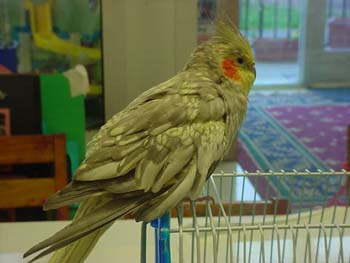
Figure 1. Bill-ee the bird.
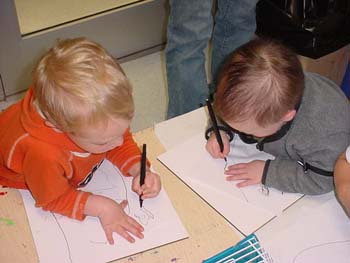
Figure 2. Jason and David draw Bill-ee.

Figure 3. Jason draws the bird's claw.
Elaine's field notes chronicled the children's process:
- The children observed Bill-ee the bird and then leaned closer to look and touch the feathers.
- At my prompt to examine the bird's claw, Jason called out, "There are only three."
- I asked the children to draw the bird, and each chose a body part to draw.
- Jason took three of his fingers and placed them onto the paper and traced only three fingers. Then he called out, "This is the bird's claw."
- Jason and David worked together, looking at the bird, then looking down at their papers to draw, then looking at each other's papers. When one would draw something, the other asked what it was and then would point to the bird to show what he was drawing.
Elaine's wrote an analysis of how her photographs represented her intent:
My images do match my intent. I wanted to observe children working together on an activity and to observe children representing their knowledge. The children were cooperative with one another and were helpful to each other throughout the process. They were able to represent their knowledge to their friends, teachers, and parents. Jason and David helped each other understand what part of the bird they were drawing by pointing to the bird when one [child] would ask [questions about the other child's drawings].. The images matched my intent because I knew what I wanted to observe.. I wanted to see children working together . to look at children's representation of knowledge, so I picked a lesson [in which] I knew the children would have to represent their knowledge that was visible.
Example 2. In this example, Angie, a master teacher, and Lisa, a novice teacher, look at photographs taken by Angie of 3-year-old children in her classroom drawing and painting a mural of paperwhite flowers (Figs. 4-7). Lisa's children are ready to begin a similar project, and she has asked Angie to meet with her to show her photographs and talk about how Angie helps children move from a drawing toward a painting phase. As Angie scrolls through her photographs on her laptop computer, a photograph of Michael appears.
Angie: Children first trace the shadows [of the flowers] with pencil and then drew over the pencil lines with fine tip markers like Michael is doing here (Fig. 4).
Lisa: But he is going off the lines!
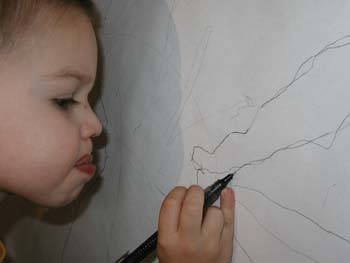
Figure 4. Michael traces the flower's shadow.
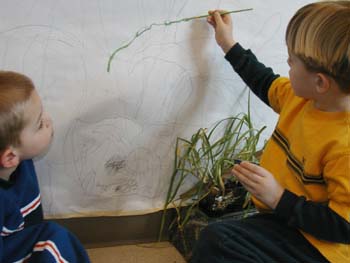

Figures 5 & 6. Children work closely to paint over traced shadow lines.
Angie: That's okay because going off the lines is not the most important thing to me. See, in these other photographs (Figures 5-6), children have to negotiate working alongside and on top of other children's earlier work.
So, what I value is not so much the final product of the mural but more about how these children learn to work closely together and seek one another out for help as they participate on a joint, shared project. I am mostly interested in how they learn to work together, not whether the youngest in the group stays on a line.
Lisa: I see. Okay, so staying on the line is not so important because he [Michael] is just 3 years old.
Angie: Yes, exactly. It is not important to me that he stay on the line but that he feels a part of the whole project . and that he develops an ability to stay focused on a task.
As Angie recalls this exchange with Lisa, she thinks about both her original intent as well as the meaning Lisa associated with the photographs. Lisa's questions and comments cause Angie to reconsider and work to state clearly what was most important to her when very young children joined with older children in a shared, and sometimes demanding, project. Angie notes,
Now, I recognize that there is a wide range of interpretations (when I share my photographs with others), and I now think about Lisa's understanding as well as my own. For me, the photographs represent children's potentials and relationships, not so much a narrow skill such as staying on a line. In fact, as we talked, Lisa told me that she had thought I had pre-drawn the lines for the children and then the children were simply tracing over them. Sharing my photographs gave me a chance to clarify that, no [I had not done the work for the children], the children had done all the work and to make a point that very young children are capable of not only drawing details but negotiating roles and responsibilities for completing a large-scale representation.
In this final photograph (Fig. 7), children stop and take a break from preparing to paint a paperwhite mural, to review photographs from one of their earlier murals.
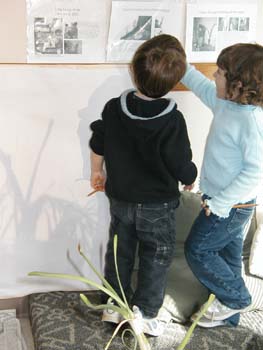
Figure 7. Children revisit photographs of their earlier paintings.
Angie describes her interaction with Lisa:
I explained what the moment represented for me to Lisa. Lisa just thought that the children were looking at the photographs out of general interest. But the children were actually looking at the photographs to recall what they did earlier to help them in their current work [with the paperwhite drawing]. Lisa was not there and did not understand the importance to me of the children using photographs as referents to guide their next steps in the process of a new painting.
Mediational
The mediational function of photography serves to link thought to action. It is situated in the act of taking a photograph. The act of bringing the camera to the eye links what is in the mind to what is happening outside, such that the camera is a tool that connects what one aims to record to what is actually recorded in a photograph. Moreover, the camera also provides a lens to focus the teacher's attention-the lens mediates between the mind's eye of the teacher and the essence of the teacher's intention. For instance, when a teacher sees something that he wants to record, he sets an intention. Consequently, the camera becomes a "mind-guided" (Whiting, 1979, p. 28) tool that mediates between (1) his intention and his action of taking a photograph and (2) his focus. In the field of photojournalism, the gestalt of this mind-set is referred to as "picture-thinking"-"the photographer, then, first learns to see with his camera and think with his eyes" (p. 34).
During this process, there are two related and concurrent actions underway. The first is the nonvisible yet deliberate decision to act. This action is informed by what is sometimes called the photographer's "gaze" (Cruickshank & Mason, 2003, p. 7; Sturken & Cartwright, 2003, pp. 76-77) or intent, such as his orientation to the study of children's learning, his interest, or his mental lens. We each have a gaze-shaped by biases, interests, and perspectives-that influences what we most want to photograph as well as what we have in mind to project to viewers of the photograph. Second, this mental orientation directs the mechanical response of taking a photograph. The physical act of holding and aiming a camera on one spot rather than on another, for example, links the head and eye to a particular place or an action in the classroom followed by yet another decision to take one, three, or a even a series of shots.
In this first example (Figs. 8-11), Angie is interested in learning how one child teaches a second child to trace the projected shadow of a leaf in preparation to paint it. The teacher's gaze or intent is clear in her mind. Angie directs the camera lens on the faces and hands of the children while including enough context (the projected shadow of the leaf) to situate the image.
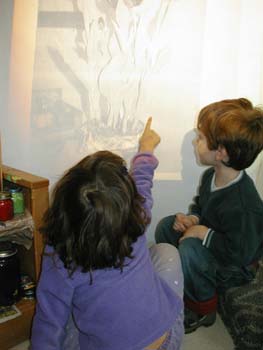
Figure 8. A child points out the shadow lines of the flower to her peer.
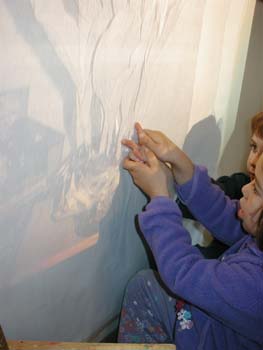
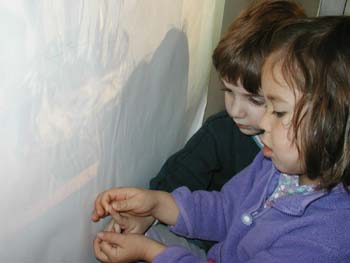

Figures 9-11. A child assists her peer in tracing shadows in preparation to paint.
The deliberateness with which she takes this series of photographs is an example of how the camera acts as her tool, the mediator, between her desire to record this classroom interaction such that she may study it later, and her focused attention in the moment. Angie later studies the photographs and revisits her understanding of how 3-year-old children appropriated skills in teaching their peers to first trace (with their fingers) the lines that they would later paint with a paint brush. In doing so, Angie has made visible the capacity and the potential of young children to "teach" their peers the skills and processes of symbolic representation for her own and the children's metacognitive analyses, as well as to communicate this capacity and potential to parents and other teachers.
For example, a senior-level preservice teacher reflected on her earlier coursework and experiences in using the camera to develop focused classroom observational skills. She told her classmates, "I don't just take [random] pictures. I wait until I see the moment of learning that I have been waiting for. I plan a lesson and when I document it, I know what learning I'm trying to see with the camera." This student describes her ability to anticipate the moment of learning on which she intends to focus. Her description reveals that she may be better "prepared to engage in subsequent similar activities" (Rogoff, 1995, p. 150), even without a camera to always mediate her focus. In this example, the student is evidencing a move away from her dependence on the camera and is beginning to appropriate9 both the tool (the camera) and the process of discernment about where to focus her attention.
The mediational function of photography is maximized when teachers participate in collective contexts of study. When groups of teachers critique photographs, diverse perspectives are often voiced as they talk out loud and think about the intention of the photographer in relation to his or her own meaning-making. The mediators are both the photographs and the conversation. In these contexts, teachers search for congruency among what is in their heads, what is being co-constructed with others, and what is represented and made visible by the teacher-photographer. In this second example of the mediational function, we begin with an excerpt from a written reflection by senior-level preservice teaching partners Lynn and Kaitlin:
Our intent to observe was focused around the social construction of knowledge. As we reviewed and discussed our photographs, we collaborated about the different types of learning that were displayed through our documentation. Lynn noticed [that] many of the pictures showed cooperative learning between the children. Kaitlin shared her realization that the expressions on the children's faces showed their high level of engagement. As she looked through the photos, Lynn realized that Kaitlin was right; all of the children were actively participating in the game. This shared understanding helped us hypothesize that this type of activity resulted in increased engagement as well as cooperative learning.. By collaborating as teaching partners, we strived to connect with each other and understand our different viewpoints.. This resulted in a "meeting of the minds" or intersubjectivity.
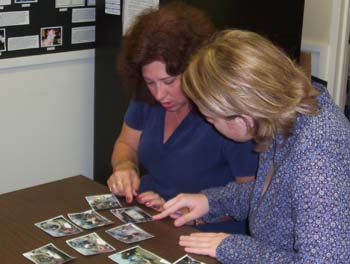
Figure 12. Preservice teachers revisit and analyze classroom photographs.
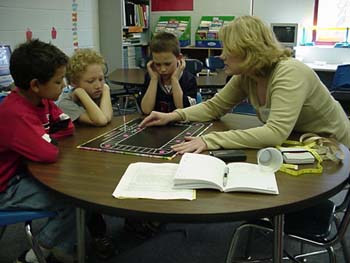
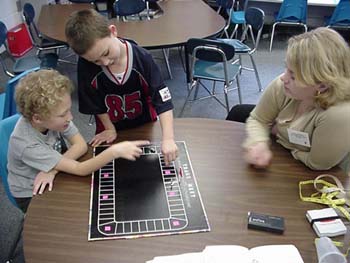
Figures 13 & 14. Children learn to play a board game.
Vision (along with speech) has the distinction of being the most important means by which we apprehend reality (Hayakawa, 1944, p. 10), or in this case, realities, such that for each photograph there is not a single reality. The language of photography is contextual, and therefore the "view" is partial. The meaning of photographs is filtered through the particular beliefs, values, and experiences of the viewer, resulting in a number of interpretations. The objective is not to hold onto our old ways of knowing, simply agreeing with the perceptions of others, including that of the creator of the photograph. Rather, "to perceive a visual image implies the beholder's participation in a process of [mental] organization. The experience of an image is thus a creative act of integration" (Kepes, 1944, p. 13). To experience an image with others means that we will likely change our minds about what we originally saw in a photograph and consequently return to our own classrooms with new mental lenses that will in turn direct and focus the very lenses located in our cameras.
Thus, once taken, photographs are used by teachers not only to make children's learning visible but also to inquire about their own gaze. This mediational function is a metacognitive process because teachers have access to records created by them that in turn help them think about their own thinking. In this case, photographs provoke questions and observations such as, "How does one child teach another the strategy of first tracing a shadowed line in preparation to later draw and then paint it?" or "What are the different types of learning that were displayed in our images?" or "How might I do a better job framing my photographs to record children's hand-use, their facial expressions, or nuances of their contemplative glances?" The answers to these questions mediate or guide teachers' inquiry. Here, the aim is to use the language of photography reflexively to discern what matters to each of us in our study of children's learning, what we are learning, and how we can more deliberately use photography to communicate our interests, our questions, and our evolving understandings with self and others.
Epistemological
The epistemological function of photography is the use of photographs as a source of new knowledge. Through individual and collective study, reflection, and analyses of photographs, teachers access the epistemic potential innate to using photography as part of the process of teaching. This epistemological process is propelled through teachers' participation in creating and using photographs. As such, teachers who use photography as a language of inquiry have a chance to continually construct new understandings about children's learning and to better understand what they want to know and "how they come to know it." For example, photographs freeze-frame moments in time so that teachers can later study them more closely, ponder their original intentions, and construct new knowledge as they return again and again to challenge old ways of knowing.
In this first of two examples, the photographs and reflective writings of a senior-level preservice teacher dyad demonstrate these teachers' epistemological understandings (Figs. 15-19).
We believe that our images clearly evidence both the teaching and learning that occurred during this activity.10 We were purposeful in the manner in which we presented the materials to the children in order to encourage autonomy in their selection of materials. Our images reveal many of the children moving immediately to solve the problem without comprehending the question that was being asked..
The images we have selected are connected to one another because they portray one child's thought process as he worked toward a solution. [The solution is to figure out how many people or animals lived in Grandpa's house to equal 12 feet and 1 tail.] The images illustrate: the presentation of the problem; the child's initial drawing; his second more logical representation; the use of Unifix cubes to prove the solution in the drawing was correct; and the culmination of the lesson in which each child's solution was presented and discussed.
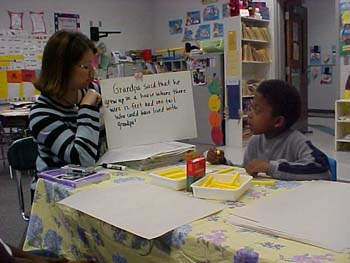
Figure 15. The teacher presents the problem to the children.

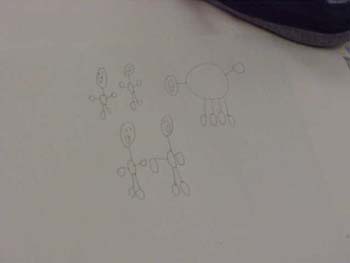
Figures 16 &17. One child represents a possible solution through drawing.

Figure 18. One child verifies his drawn solution with manipulatives.
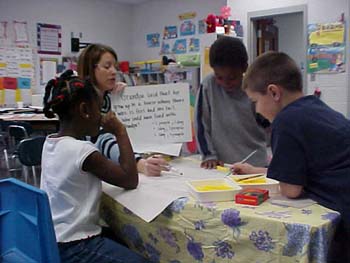
Figure 19. Children meet to revisit their solutions to the problem.
As a teaching team, we differ in what we might adapt if we were going to teach this lesson again in the future. One of us feels that we might allow more time to explore other solutions that were not generated by the group. The other would prefer to introduce additional materials to the children with which to solve the problem such as figurines of people and animals. This adaptation might assist the children who were having problems solving the problem in more abstract ways.
Through the language of photography, a disposition of inquiry is developed-to observe, to see and see again with discernment, and to construct meaning. These epistemic processes are initially and intermittently dependent upon the aid of tools (cameras, lenses) and signs (photographs). Yet the language of photography does not remain solely on the external plane. Instead, over time, it is likewise appropriated and used mentally on one's personal or internal plane. From this perspective, the construction of meaning develops both in the head of the teacher as well as in her hands; that is, in the manipulation of the camera and in the adjustment of her lens as well as in her rationale for what to record. At these times, the teacher's conceptual constructs developed from so many photographs taken, so many conversations shared, and so many new understandings inform her decisions and beliefs about what is important to photograph to her. She is not only photographing for the moment but also for broader purposes: her particular interests, her need to know more, her developing focus of inquiry. And these purposes are simultaneously re-informed by an individual teacher's conceptual constructs.
In this second and final example of the epistemological function, we once again consider a master teacher's use of photography as she sets her sights on a question about children's understanding of measurement for which she does not have a ready answer. It is spring, and outside the multi-age preschool classroom, Angie and the children have planted a flower garden. On this day, six children go out together to explore the flowers. Angie's goal was to determine what the children were most curious about so that she could plan relevant follow-up activities to help them explore their questions and observations. She documented their interests not only by what they said but "how long they stayed focused and how they explored an aspect of a flower and how they oriented their bodies to the plants" (Figs. 20-30).
Angie recalls the day,
At first, I took many photographs to study their pure explorations. I then began to focus on their questions, and I audiotaped their conversations. I wondered what they wanted to know and how to help them investigate it through their experiences and later through their study of photographs of their experiences. I listened for their questions.
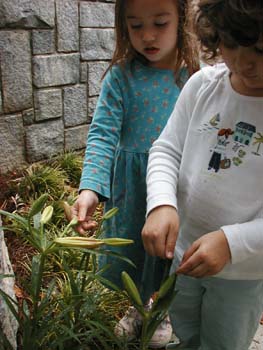
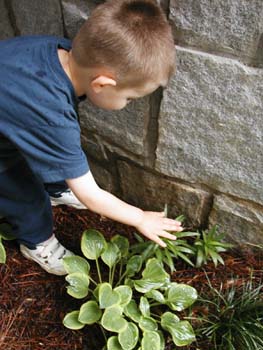


Figures 20-23. Children explore flowers in the garden.
That morning, among the observations posed by the children, Susan and Danielle noted, "it's too little," meaning that they could not measure the height of the tall lilies with their 12-inch ruler. It was this problem, first posed by Susan and later explored by Danielle, that most caught Angie's attention. Angie wanted to know, "What does Danielle understand about measuring?" and "Do I give her a longer measuring tool or, instead, wait and encourage her to continue to figure out her own solutions to the problem?"

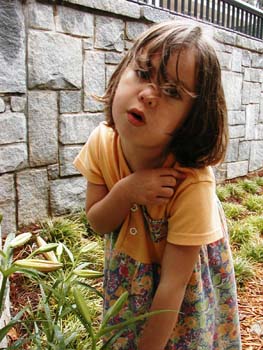

Figures 24-26. Danielle extends the ruler with her hand and arm to measure the lily.
Teacher: What do you mean it is too little?
Danielle: Because the flower's tall.
Teacher: How do you think we can measure the flower?
Danielle: I'll do it with my hand.
Teacher: How are you going to use the ruler to measure?
Danielle: Here, I'll show you. It's 20: 1, 2, 3, 4, 5, 6, 7, 8, 9, 10 buds. I'll make my hand go up.
Teacher: Oh, I see you are connecting your hand to the ruler for the rest of the flower's height. What can we connect? Your hand doesn't have numbers, so how will we measure?
Danielle: I'll count. (counting on the ruler): 1, 2, . 12 (to end of ruler, then on arm) . 24.
Teacher: How can we tell how long your arm is?
Danielle: My mommy said I can't draw on my arm.
Teacher: Ok, how can we know how long your arm is?
Angie reflects on her process:
I studied the photographs and transcriptions over and over. I was confused. At first, I didn't know what Danielle meant about how she was using her arm to help her measure. I kept photographing her as she talked to me about how she would extend the ruler with her arm to make a long enough tool to measure the lilies.
Angie was not only photographing for the moment but also for broader purposes. In the moment, Angie used the photographs to help Danielle revisit her strategies of inquiry for determining how to measure a tall flower with a ruler that was shorter than the flower. On a broader level, Angie further developed her own focus of inquiry through her study and guidance of Danielle's cycle of inquiry.
Angie continues:
As Danielle talked to me, she used two words (much and old) that aren't usually used to describe height. I kept asking her [clarifying] questions because while I believed she understood what she meant, I was still confused.
Danielle: Let's count again. When the flower comes to my hand, then we'll count the numbers: 1, 2, 3, 4, 5, 6, 7, 8, 9, 10, 11, 12 (begins using hand and arm as measuring device when ruler runs out), 13, 14, 15, 16. It's 16 much.
Teacher: What is much?
Danielle: Much means 16.
Teacher: But what is much?
Danielle: Much means 20: 20 years old.
Teacher: Are we talking about how tall or how old?
Danielle: It is just this tall, okay? Let's measure the tall one. I hope it goes up to my arm up here (pointing to the edge of her shoulder again). I have to go down for 1 . and up to16. That's 16 much old.
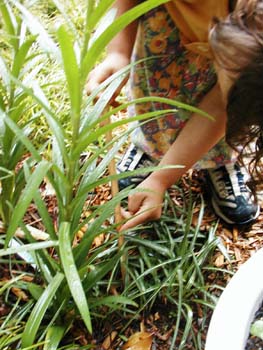
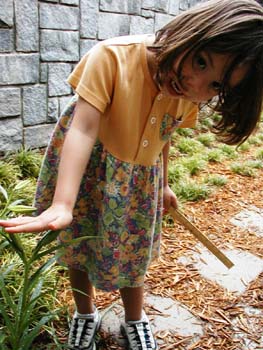
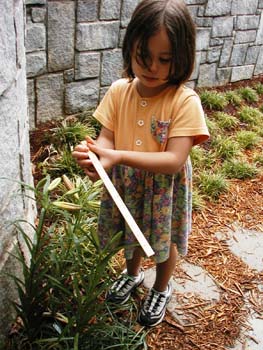
Figures 27-29. Danielle studies the height of the plant.
Angie goes on to say:
Later, I read over the transcriptions and looked again and again at the photographs, ordering and re-ordering them, arranging them alongside her transcribed words. I began to understand that she used the words "old" and "much" interchangeably to describe units of length. What I mean is that when Danielle first used the words old and much, she understood her meaning but I didn't, until I studied my photographs and her words with her.
The next day, Angie invited Danielle to revisit the series of photographs in order to help Angie clarify exactly how Danielle conceptualized extending the ruler (using her arm) to measure the lily. In these photographs, Angie rechecks her interpretation of Danielle's thinking about measurement (Figs. 30-32). As they looked at the photographs together, Angie read Danielle's words to her. Danielle was able to restate her thinking to Angie and confirm Angie's original hypothesis. Angie says, "I learned that she had a far more sophisticated understanding of measurement than I knew, and I used this to plan other measuring activities for her."
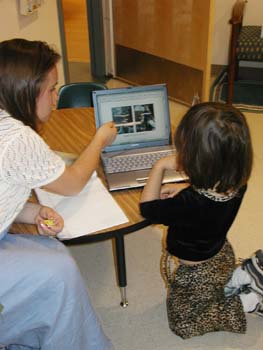
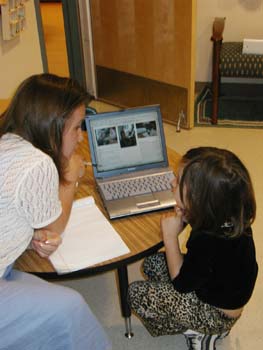
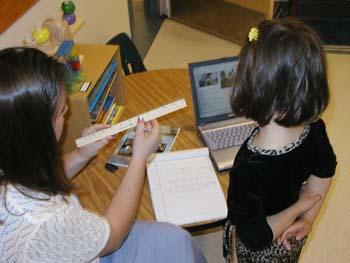
Figures 30-32. Angie and Danielle revisit photographs of measuring the lily.
From here, Angie was able to create subsequent classroom tasks using manipulatives to continue to test Danielle's thinking strategy in another context (Fig. 33-35).
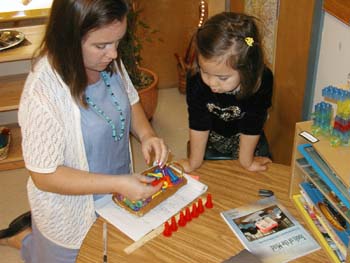
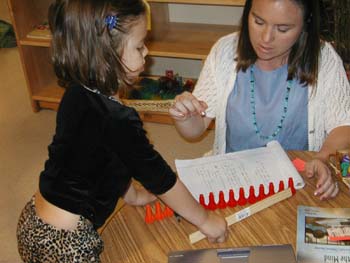
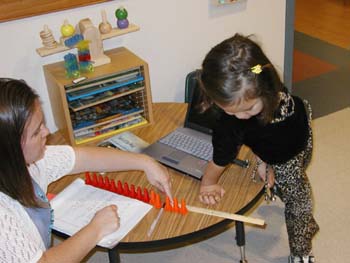
Figures 33-35. Angie presents Danielle with a new counting task back in the classroom.
Through the coupling of transcriptions with photographs and by sharing these with Danielle, Angie decoded the information and constructed new understandings about Danielle's problem solving. Concurrently, Angie appropriated this strategy (studying photographs with text and sharing it with others) to refine and expand her repertoire of inquiry practices-even as she engaged in the metacognitive process of recognizing what she wanted to know and how she came to know it. That is, there comes a time when focusing the camera lens, manipulating photographs, and reading transcriptions become a mental gestalt of actions that occur in the head of the teacher, with increasingly less reliance on the actual tools or actions themselves.
Thus, the epistemological function of photography contributes to teachers' knowledge about and processes of learning through inquiry. Photography makes visible the metacognitive processes of teaching and learning. The acts of focusing attention to capture images of classroom moments, manipulating photographs, studying transcripts, and developing interpretive meanings and text are processes that encourage the development of metacognition in teachers. These processes are made visible through the act of documentation and are appropriated by teachers when inquiry becomes a habit of mind, even without the presence and manipulation of tools and documents.
Concluding Remarks
Photography as a language of inquiry is therefore generative and communicative-generative because through photography teachers construct new understandings and are more prepared to engage in subsequent similar activities and communicative because photography conveys and provokes meaning. Thus, photography can be a powerful research tool for educating students and teachers in the construction and co-construction of knowledge about the processes of teaching and learning; and as well, photography is one way to make visible these same processes.
In this article, we attempt to situate photography in teacher education within the broader frameworks of visual anthropology, visual sociology, photojournalism, and media literacy. For educators in the digital age, photography is an effective and rich resource that expands both the tools (writing utensils, computers, tape recorders) and the records (field notes, work samples, transcriptions) that we use in our classrooms to include cameras and photographs. We present descriptions and examples of three functional applications of photography in classroom investigations. The representational, mediational, and epistemological functions of photography are useful in explaining how teachers use photography as a language of teacher inquiry. The use of photography as a functional language of inquiry in education is portrayed as a means for moving the field of education toward visual literacy.
Finally, early childhood education is a field in which visual documentation techniques are emerging, and as such, the functional categories of photography presented here are one means to give substance and clarity to our burgeoning understanding of praxis in a visually literate world. In this article, we chose specific examples from preschools and early elementary schools to illustrate each of these functions. Although the examples are taken from early childhood classrooms, we believe that the information presented here has application to the broader field of education, precisely because of its inherent adaptability to cultural contexts. As educators learn to use photography to construct new understandings and to convey meaning in classroom contexts, it is our hope that this article provides one means by which they may begin to articulate their use of photography as both a generative and a communicative language of teacher inquiry.
Notes
1. Visual anthropology and visual sociology are more recent, secondary variations of the larger fields.
2. While documentary film, more than photography, has dominated the above-mentioned fields (Hall, 1997; Sturken & Cartwright, 2003), it is beyond the scope of this article to discuss both film and photography. Therefore, the focus of this article is on the use of still photography in teacher inquiry.
3. Documentation is the purposeful gathering, systematic organization, and use of diverse symbolic representations that depict multiple perspectives of children and teachers' constructions of knowledge (Tegano & Moran, 2005). "It is . an instrument of exchange and sharing. These acts of recording, of documenting, are not passive. They continually propel the educator to a fuller understanding of what happens in the learning process" (Tarini, 1993).
4. Information about Bey may be found on this Web site: http://www.dia.org/dawoud_bey_site/introduction.html.
5. Para-proxemics refers to the "framing variable," that is the "choice of close-ups, medium shots or long shots" used to frame the portrayed scene that influences the viewers' perception and response to the image (Meyrowitz, 1986, p. 256).
6. This notion infers that a documentary photograph is a "simple record . its factual or objective basis seems at first glance quite unexceptional . a way of presenting 'facts' about its subject in a purely informational way" (Hamilton, 1997, p. 81).
7. There is an argument among some contemporary researchers in the fields of visual anthropology and visual sociology, in particular, that the use of photographs as a central form of data is problematic (Harper, 1998). Some of the arguments reviewed by Prosser (1998) include (1) photographs are too complex and ambiguous, (2) the act of taking photographs "alters the objective content and subjective meaning of the image ." (p. 98), and (3) the social construction and mediational nature central to creating and "reading" photographs distorts their meaning and diminishes their usefulness as data. If the goal of teacher inquiry is to pose hypotheses and generate/analyze data, then these arguments may also hold true for teachers engaged in classroom research. However, teacher inquiry does not typically aim to prove or disprove a theory or to ensure that there is only one truth represented in a photograph. Rather, inquiry-oriented practice is a cyclical process from which teachers pose problems, questions, reflections, and challenge prior ways of thinking and practicing, as they represent and re-represent the extraordinary in the ordinary learning lives of teachers and children.
8. All participants' names have been replaced with pseudonyms.
9. Participatory appropriation is a "process by which individuals transform their understanding of and responsibility for activities through their own participation.." As a result, they are then better prepared to engage in similar types of activities in the future (Rogoff, 1995, p. 150).
10. Grandpa said that he grew up in a house where there were 12 feet and 1 tail. Who could have lived with Grandpa? This activity was taken from Young Children Reinvent Arithmetic: Implications of Piaget's Theory by Constance Kamii (2000).
Acknowledgment
The authors wish to acknowledge the valuable contribution of documentation by master teacher-photographer Angelia Beth Jenkins, B.S. Angie is a teacher and curriculum coordinator in a private preschool in Georgia. She recently presented her work at the National Association for the Education of Young Children 2004 annual conference in Anaheim, California.References
Banks, Marcus. (1998). Visual anthropology: Image, object and interpretation. In Jon Prosser (Ed.), Image-based research: A sourcebook for qualitative researchers (pp. 9-23). New York: RoutledgeFalmer.
Bateson, Gregory, & Mead, Margaret. (1942). Balinese character: A photographic analysis (Vol. 2). New York: New York Academy of Sciences.
Burnaford, Gail; Fischer, Joseph; & Hobson, David (Eds.). (2001). Teachers doing research: The power of action through inquiry (2nd ed.). Mahwah, NJ: Erlbaum. ED 454 170.
Cochran-Smith, Marilyn, & Lytle, Susan L. (2001). Beyond certainty: Taking an inquiry stance in practice. In Ann Lieberman & Lynne Miller (Eds.), Teachers caught in the action: Professional development that matters (pp. 45-60). New York: Teachers College Press. ED 454 205.
Collier, John, Jr. (1995). Photography and visual anthropology. In Paul Hockings (Ed.), Principles of visual anthropology (2nd ed., pp. 235-254). New York: Mouton de Gruyter.
Collier, John, Jr., & Collier, Malcolm. (1986). Visual anthropology: Photography as a research method (Rev. ed.). Albuquerque: University of New Mexico Press.
Cruickshank, Iona, & Mason, Rachel. (2003). Using photography in art education research: A reflexive inquiry. International Journal of Art and Design Education, 22(1), 5-21.
de Brigard, Emilie. (1995). The history of ethnographic film. In Paul Hockings (Ed.), Principles of visual anthropology (2nd ed., pp. 13-43). New York: Mouton de Gruyter.
Edwards, Elizabeth (Ed.). (1992). Anthropology and photography 1860-1920. New Haven, CT: Yale University Press.
Fosnot, Catherine T. (1989). Enquiring teachers, enquiring learners: A constructivist approach for teaching. New York: Teachers College Press.
Fu, Victoria R.; Goldhaber, Jeanne; Tegano, Deborah W.; & Stremmel, Andrew. (2000, November). Recasting the Reggio Emilia approach: Defining ourselves through visual images and the multiple voices of collaborative research. Paper presented at the annual conference of the National Association for the Education of Young Children, Atlanta, GA.
Geertz, Clifford. (1973). The interpretation of cultures. New York: Basic Books.
Goldman-Segall, Ricki. (1998). Points of viewing children's thinking: A digital ethnographer's journey. Mahwah, NJ: Erlbaum.
Hall, Stuart (Ed.). (1997). Representation: Cultural representations and signifying practices. Thousand Oaks, CA: Sage.
Hamilton, Peter. (1997). Representing the social: France and Frenchness in postwar humanist photography. In Stuart Hall (Ed.), Representation: Cultural representations and signifying practices (pp. 76-87). Thousand Oaks, CA: Sage.
Harper, Douglas. (1998). An argument for visual sociology. In Jon Prosser (Ed.), Image-based research: A sourcebook for qualitative researchers (pp. 24-41). New York: RoutledgeFalmer.
Hayakawa, S. I. (1944). The revision of vision. In Gyorgy Kepes, Language of vision. Chicago: Paul Theobald.
Hill, Lynn T.; Stremmel, Andrew J.; & Fu, Victoria R. (2004). Teaching as inquiry: Rethinking curriculum in early childhood education. New York: Allyn & Bacon.
Hubbard, Ruth Shagoury, & Power, Brenda Miller. (2003). The art of classroom inquiry: A handbook for teacher-researchers (Rev. ed.). Portsmouth, NH: Heinemann.
Kamii, Constance. (2000). Young children reinvent arithmetic: Implications of Piaget's theory (2nd ed). New York: Teachers College Press. ED 458 123.
Kepes, Gyorgy. (1944). Language of vision. Chicago: Paul Theobald.
Lawrence-Lightfoot, Sara. (1999). Respect: An exploration. Reading, MA: Perseus Books.
Messaris, Paul. (1998). Visual aspects of media literacy. Journal of Communication, 48(1), 70-80.
Meyrowitz, Joshua. (1986). Television and interpersonal behavior: Codes of perception and response. In Gary Gumpert & Robert Cathcart (Eds.), Inter/media: Interpersonal communication in a media world (3rd ed., pp. 253-272). New York: Oxford University Press.
Moran, Mary Jane. (2002). Implications for the study and development of inquiry among early childhood preservice teachers: A report from one study. Journal of Early Childhood Teacher Education, 23(1), 39-44.
Project Zero, Cambridgeport Children's Center, Cambridgeport School, Ezra H. Baker School, & John Simpkins School. (2003). Making teaching visible: Documenting individual and group learning as professional development. Cambridge, MA: Project Zero.
Project Zero and Reggio Children, Italy. (2001). Making learning visible: Children as individual and group learners. Reggio Emilia, Italy: Reggio Children S.r.l. and Reggio Children/USA.
Prosser, Jon (Ed.). (1998). Image-based research: A sourcebook for qualitative researchers. New York: RoutledgeFalmer.
Rogoff, Barbara. (1995). Observing sociocultural activity on three planes: Participatory appropriation, guided participation, and apprenticeship. In James V. Wertsch, Pablo del Rio, & Amelia Alvarez (Eds.), Sociocultural studies of mind (pp. 139-164). Cambridge, UK: Cambridge University Press.
Rose, Gillian. (2001). Visual methodologies: An introduction to the interpretation of visual materials. Thousand Oaks, CA: Sage.
Sturken, Marita, & Cartwright, Lisa. (2003). Practices of looking: An introduction to visual culture. New York: Oxford University Press.
Tarini, Eva. (1993). What is documentation? Innovations in Early Education: The International Reggio Exchange, 1(4), 4-5.
Tegano, Deborah W., & Moran, Mary Jane. (2005). Conditions and contexts for teacher inquiry: Systematic approaches to preservice teacher collaborative experiences. Manuscript submitted for publication.
Whiting, John R. (1946/1979). Photography is a language. New York: Arno Press.
Winston, Brian. (1998). "The camera never lies": The partiality of photographic evidence. In Jon Prosser (Ed.), Image-based research: A sourcebook for qualitative researchers (pp. 60-68). New York: RoutledgeFalmer.
Author Information
Dr. Mary Jane Moran is an assistant professor of early childhood education at the University of Tennessee, Knoxville, in the Department of Child and Family Studies. She teaches undergraduate and graduate courses on early childhood education, action research, and early learning environments and curriculum. Her research interests include the study and development of teachers engaged in collaborative action research, the use of documentation as a tool for developing critical thinking among teachers, and the role of photography and film as languages of teacher inquiry. She and Dr. Deborah W. Tegano have developed Web-based approaches for helping preservice teachers develop critical thinking through visual literacy.
Mary Jane Moran, Ph.D.
The University of Tennessee
Department of Child and Family Studies
1215 West Cumberland Avenue, Room 115
Knoxville, TN 37996-1912
Telephone: 865-974-4538
Email: mjmoran@utk.edu
Dr. Deborah W. Tegano is an associate professor of early childhood education at the University of Tennessee, Knoxville, in the Department of Child and Family Studies. She teaches undergraduate and graduate courses on early childhood education, action research, and children's play. Her research interests include inquiry-based curriculum development, teachers' roles in promoting problem solving through play, and the role of photography and film as languages of teacher inquiry. She and Dr. Mary Jane Moran have developed Web-based approaches for helping preservice teachers develop critical thinking through visual literacy.
Deborah W. Tegano, Ph.D.
The University of Tennessee
Department of Child and Family Studies
1215 West Cumberland Avenue, Room 115
Knoxville, TN 37996-1912
Telephone: 865-974-4538
Email: dwtegano@utk.edu

